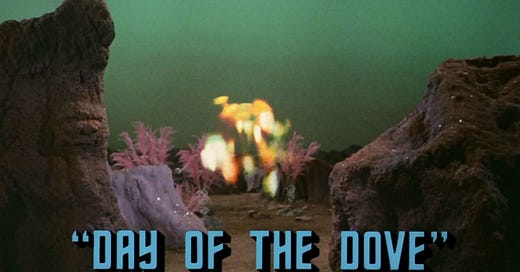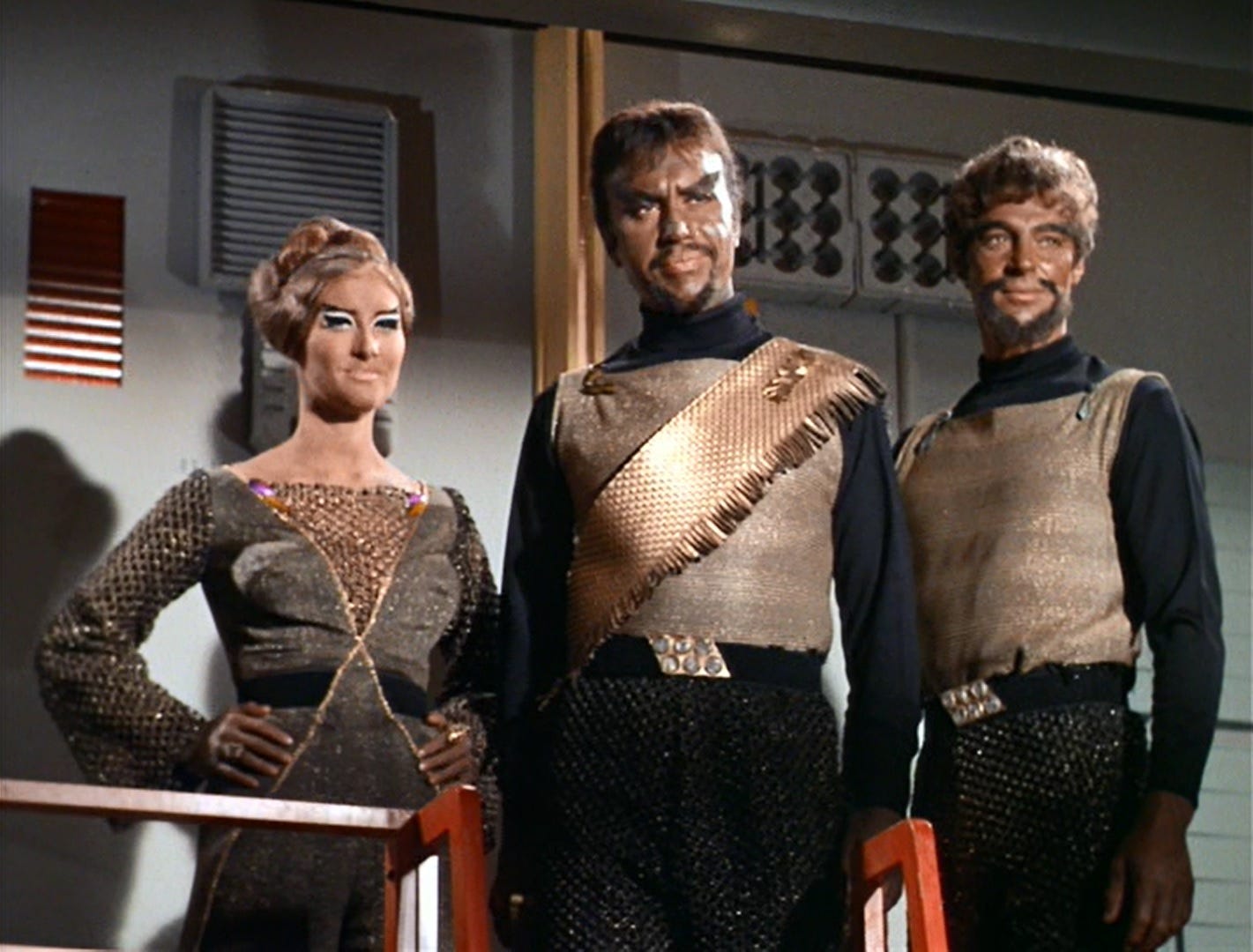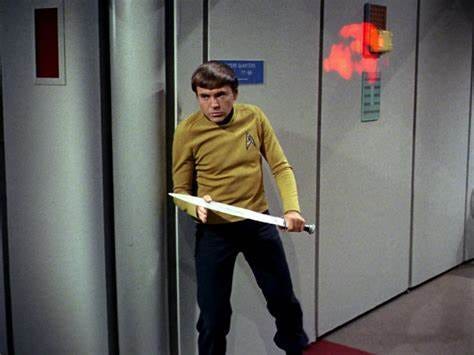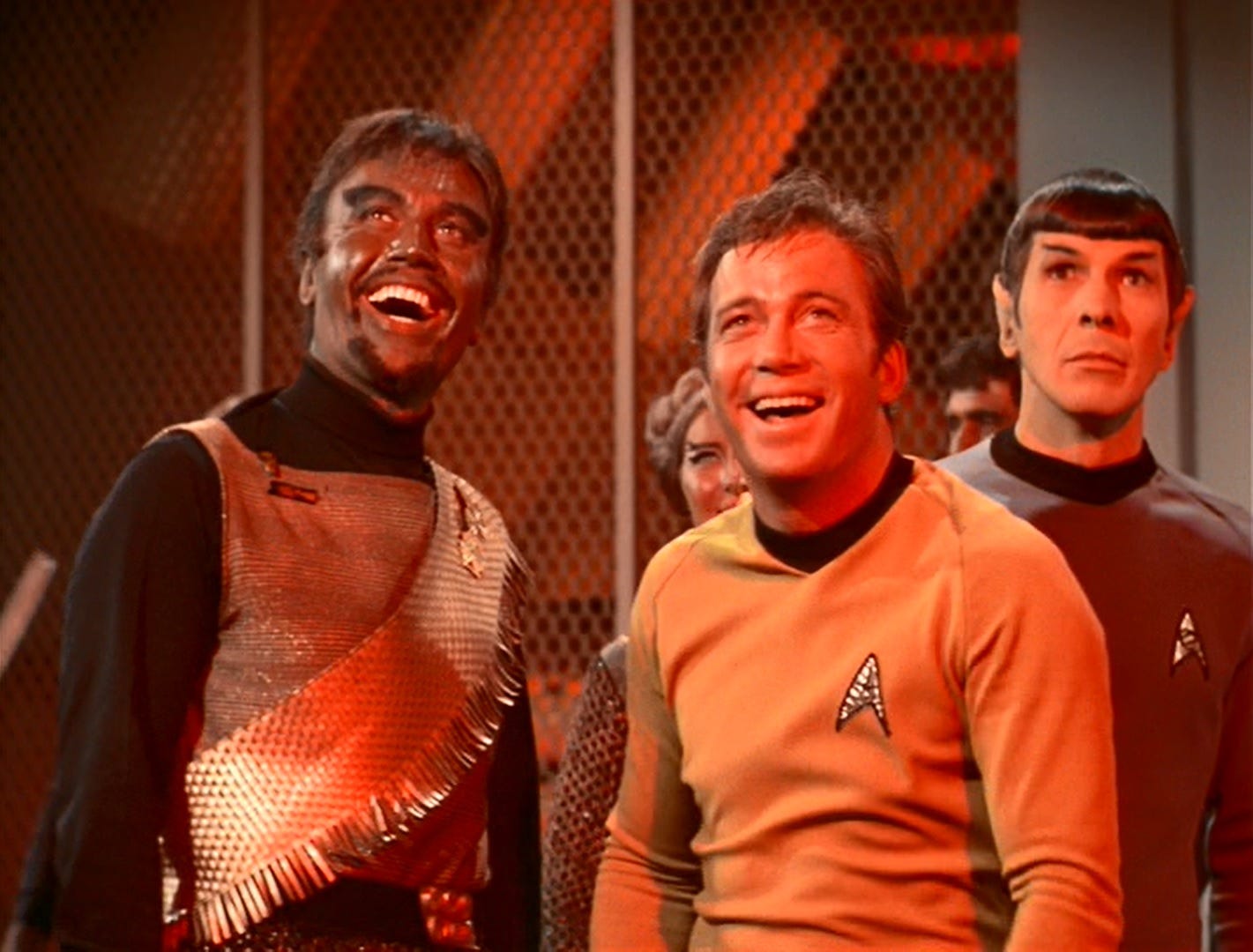It would be unfair to accuse Star Trek of having run out of ideas. This is only the sixty-second episode of a franchise that spans nearly one thousand episodes of television and twelve films. But The Original Series has some standard plots that we have touched on before, often falling back on all-powerful energy beings who manipulate the Enterprise crew into situations that are only overcome by appealing to humanity’s better aspects. “Day of the Dove” is no different. Despite this, the strongest Star Trek episodes use aesthetic and thematic gloss to vary that basic premise. “Charlie X” emphasizes the all-powerful being’s adolescent masculinity. “Arena” questions the use and propriety of violent moral tests. “Who Mourns for Adonais?” played with culturally ambient theories of ancient aliens masquerading as polytheistic gods to question whether faithful obedience to such beings is moral at all. Most recently, “Specter of the Gun” constructed surreal sets based on historically violent Western expansion, demonstrating that the past need not be the future.
“Day of the Dove” just has Klingons.
Klingons are fun. At this point, the warmongering empire is the most recurring antagonist the show has portrayed. Never quite a mere Soviet analogue - a decision that would have been all too easy in 1968 - the Klingons of The Original Series are instead an amalgamation of slightly problematic Orientalist historical views, ancient Mongolian aesthetics, and violent “honor culture” attitudes that have existed throughout human societies as varied as the Antebellum South and the extreme Wahabist states of today. They are an excellent foil for the peaceful, secular, multicultural Federation. But a fun piece of lore does not a story nor an episode make. Merely having Klingons will not elevate an episode to all but the most diehard fans. Having Klingons in an episode with the exact same thematic structure as the previous week’s feels lazy.
The similarities between what “Day of the Dove” and “Specter of the Gun” say are miniscule. Both emphasize how humanity can, with enough time and willpower, move past its violent impulses towards something resembling a pure rationality. But where “Specter of the Gun” uses unique visual stylings to ground its ideas in true history, “Day of the Dove” locks the crew aboard the Enterprise on an episode of “Deadliest Warrior.” Granted, the responsibility for the thematic repetition does not fall on the creatives but the network; production codes reveal that “Day of the Dove” came ten episodes later for the crew than it did for viewers. But the point stands that the two provide an almost identical story. “Day of the Dove” is done no favors by comparison.
The basic set up is this: the Enterprise and a Klingon ship are both called to an abandoned planet by a phantom distress signal, at which point the Klingon ship is mysteriously disabled. Kirk agrees to ferry the Klingon refugees to safety despite the hostility - up to an unsuccessful attempt to seize the Enterprise - of Kang, the Klingon Commander, who suspects the Enterprise is responsible for the whole ordeal. His stress is understandable though; his wife and science officer, Mara, was nearly killed as a result. When Kirk resists Kang’s aggressive commands to surrender his ship, he tells him to “Go to the Devil” in an obvious bit of network censorship. “We have no devil, Kirk. But we understand the habits of yours,” is Kang’s characteristic reply.
As Kirk and crew sort out the logistics of transporting a hostile, hardly cooperative group of Klingons, an odd red cloud floats around the ship. Wherever it goes, people seem to get angry. Chekov, in particular, seems incensed by the presence of Klingons, the empire having killed his brother Piotr during the previous war.
The episode’s main Klingon antagonists, with Mara (Susan Howard) to the left of her husband Kang (Michael Ansara). Howard saw later success in an eight-year gig on Dallas as Donna Culver; after leaving acting she became a conservative political activist in leadership for the National Rifle Association and the Texas Republican Party. Michael Ansara’s career was a typical one for any non-white (but non-black) actor in mid-Century Hollywood. Of Syrian heritage, he was often cast as Arabic - in Biblical Epics - or Native American - in Westerns. In the television spin-off of the Jimmy Stewart Western Broken Arrow, Ansara played Cochise. In his late career, he reprised the role of Kang in other Star Trek shows and voiced Mr. Freeze on Batman: The Animated Series.
The cloud pulls other tricks too. It accelerates the Enterprise to near-maximum warp speed, locks nearly all of the crew - sans our main characters of course - belowdecks, and turns all phasers into swords. Chekov’s brother is revealed as a false memory, implanted to gin up his anger. When all is said in done, two forces of equally armed and manned power are primed through cultural suspicion, violent history, and present stress to face off. A battle erupts. The Klingons seize a deck and seek to choke out the remaining Federation crew.
All of this proves interesting to Spock. He manages to detect the cloud on the ship’s sensors and determines that it literally feeds off aggression. Hostility, rage, and heightened emotion sustain the being. In a hermetic environment like the Enterprise, it can keep the crew alive, heal any wounds from the fighting, and keep tensions high for eternity. Like a vampire that has caught a bleeding immortal, the cloud looks on the ship as a kind of perpetual motion machine.
The cloud hovers above Chekov, turning him into a real bastard. Chekov’s momentary sexual assault of Mara - he gropes her before Kirk and Spock intervene - is the episode’s most uncomfortable and shocking moment.
Kang and Kirk’s back and forth is the episode’s spine, and Ansara is an able presence for a character that is perhaps a bit thin. Individual Klingons are always representational of their culture in The Original Series - none deviate from their established aggression in attitude or goal - and thus Klingon guest performances feel derivative and one note. Ansara’s is no different: big bark, declarative sentences, the works. But Kang gets shades previous Klingon’s have not, largely due to the presence of his wife, Mara. Howard’s performance is nothing special, and Mara’s role is purely instrumental, but this first look at a female Klingon at least allows the opposing empire the idea of love and connection. Mara is initially as gung-ho as her husband for seizing the Enterprise and killing its crew. After being captured - and nearly sexually assaulted - by a functionally bloodlusted Chekov, Mara finds herself saved by Kirk and Spock, who have puzzled out the cloud’s biology and plan.
Credit to the writers then that Mara remains skeptical of the Federation even after her rescue. No damsel, she remains a defiant prisoner unwilling to convince her husband to stand down. Her hostile attitude only gives way after Kirk’s gambit to extort a ceasefire with a threat on her life fails; Kang proves willing to let her die as a casualty of war rather than surrender and calls Kirk’s bluff. Credit again then, that Mara proves neither furious at her husband - who was only following his culture’s seemingly universal moral code - nor overly grateful to Kirk for sparing her. Instead, she only finds herself convinced that the aggression of the Enterprise crew towards them may not be inherent to humans, but a consequence of the cloud she has seen and had explained. She agrees to help find a peace: “I will take you to Kang. I will add my voice to yours.”
Kang and Kirk laugh off their differences and banish the energy vampire cloud to the depths of space. While the conclusion is perhaps a bit pat, it is enjoyable to see a Klingon character not characterized solely by shouting and haughty superiority.
Her voice proves enough. Kirk and her use intra-ship teleportation to appear in the Klingon stronghold and confront Kang, while the brainwashed Enterprise crew attack the Klingon guards. Kang engages Kirk in a swordfight as the later pleads for peace. The cloud appears over their fight like an eager spectator in the Roman coliseum and Kirk gives up the pretense of defending himself altogether.
KIRK: Look! Look, Kang. For the rest of our lives. A thousand lifetimes. Senseless violence, fighting, while an alien has total control over us.
(Kirk throws away his sword.)
KIRK: All right. All right. In the heart. In the head. I won't stay dead. Next time I'll do the same to you. I'll kill you. And it goes on, the good old game of war, pawn against pawn! Stopping the bad guys. While somewhere, something sits back and laughs and starts it all over again.
Declaring that “Klingons kill for their own purposes,” Kang lays down his arms. The two crews then begin to mock the cloud, telling it to leave, laughing in its face in comradery. The cloud disappears, the ship slows, and Kang declares that “only a fool fights in a burning house.” The alien, so clearly a stand-in for intoxicating hate, is banished by mirth. Your mileage with this may vary. After all, World War I continued for five years after the Christmas Truce. But coming so soon after the daring and visually arresting “Specter of the Gun,” “Day of the Dove,” feels hollow and repetitive, with moments of interest but an impact as light and ephemeral as its main metaphor.
Stray Thoughts
The episode provides Spock’s perspective on racism after being put under the influence of the cloud. “I too felt a surge of racial bigotry. Most distasteful.”
While the episode feels rote, it does execute the standard plot fairly well. In particular, the audience is given both the Federation and Klingon perspective throughout, rather than locking you into only what the “good” main characters are doing. By showing both sides of the conflict, the stakes are raised and the eventual reconciliation feels more radical.








Interesting article. I always really like "Day of the Dove" but not "Spectre of the Gun." I think it was the minimalistic sets of the latter (due to budget cuts) that ruined the illusion for me in that episode. Interestingly, the producers, Gene Coon, Roddenberry, and others, were always struggling with whether they were repeating plots, how to disguise it when they had to (again, usually because of spartan budgets), etc. You can read their memos back and forth on this in Marc Cushman's "These Are The Voyages" books on the making of TOS.